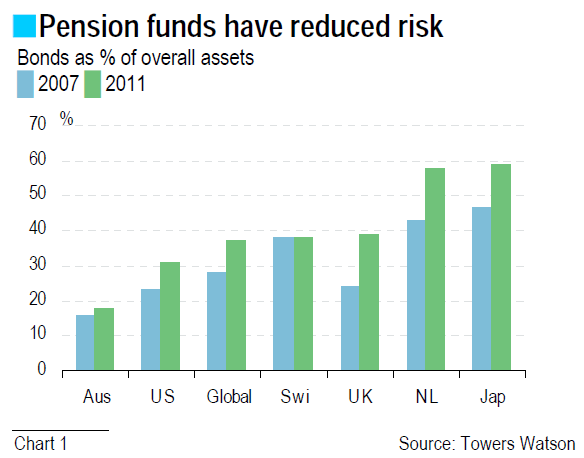Following the Great Recession, interest rates has been at historically low levels. This is partly related to the almost zero interest rate policies implemented by the major central banks and the quantitative easing measures which aim at lowering nominal rates below levels that would otherwise prevail. Moreover, the emerging economies are keen on investing in the developed economies (f.e. US T-Bonds) to prevent their currencies from appreciating. In most of the industrial world real interest rates have turned negative.
The large role for non-market forces in the determination of interest rates which is a key feature of what Carmen M. Reinhart calls financial repression1. Financial repression includes directed lending to the government by captive domestic audiences such as pension funds or domestic banks. It takes many forms such as
the explicit caps on interest rates, regulation of cross-border capital flows, and relatively high reserve requirements.
When financial repression results in negative interest rates, it works as a transfer from creditors to borrowers. This facilitates the servicing of the high public sector debt in the industrialised world. Hence, Mrs Reinhart calls this transfer a financial repression tax. As this tax operates in a rather opaque way, often justified by prudential regulations, this result is a more palatable solution for deficit reduction than outright tax hikes or expenditure reductions.

Forced on a sovereign debt diet
Encouraged by new pension regulations such as the introduction of mark to market accounting, pension funds, particularly defined benefit plans, have steadily reduced the risk on their portfolio in recent years by increasing the share of fixed income products in their portfolio (chart 1). This movement was accelerated by disappointing returns on equity investment after the bursting of the dotcom bubble and the 2008 credit crisis.
To Read the Entire Report Please Click on the pdf File Below.
- English (UK)
- English (India)
- English (Canada)
- English (Australia)
- English (South Africa)
- English (Philippines)
- English (Nigeria)
- Deutsch
- Español (España)
- Español (México)
- Français
- Italiano
- Nederlands
- Português (Portugal)
- Polski
- Português (Brasil)
- Русский
- Türkçe
- العربية
- Ελληνικά
- Svenska
- Suomi
- עברית
- 日本語
- 한국어
- 简体中文
- 繁體中文
- Bahasa Indonesia
- Bahasa Melayu
- ไทย
- Tiếng Việt
- हिंदी
Hard Times For Pension Funds
Published 10/26/2012, 07:53 AM
Updated 03/09/2019, 08:30 AM
Hard Times For Pension Funds
Latest comments
Loading next article…
Install Our App
Risk Disclosure: Trading in financial instruments and/or cryptocurrencies involves high risks including the risk of losing some, or all, of your investment amount, and may not be suitable for all investors. Prices of cryptocurrencies are extremely volatile and may be affected by external factors such as financial, regulatory or political events. Trading on margin increases the financial risks.
Before deciding to trade in financial instrument or cryptocurrencies you should be fully informed of the risks and costs associated with trading the financial markets, carefully consider your investment objectives, level of experience, and risk appetite, and seek professional advice where needed.
Fusion Media would like to remind you that the data contained in this website is not necessarily real-time nor accurate. The data and prices on the website are not necessarily provided by any market or exchange, but may be provided by market makers, and so prices may not be accurate and may differ from the actual price at any given market, meaning prices are indicative and not appropriate for trading purposes. Fusion Media and any provider of the data contained in this website will not accept liability for any loss or damage as a result of your trading, or your reliance on the information contained within this website.
It is prohibited to use, store, reproduce, display, modify, transmit or distribute the data contained in this website without the explicit prior written permission of Fusion Media and/or the data provider. All intellectual property rights are reserved by the providers and/or the exchange providing the data contained in this website.
Fusion Media may be compensated by the advertisers that appear on the website, based on your interaction with the advertisements or advertisers.
Before deciding to trade in financial instrument or cryptocurrencies you should be fully informed of the risks and costs associated with trading the financial markets, carefully consider your investment objectives, level of experience, and risk appetite, and seek professional advice where needed.
Fusion Media would like to remind you that the data contained in this website is not necessarily real-time nor accurate. The data and prices on the website are not necessarily provided by any market or exchange, but may be provided by market makers, and so prices may not be accurate and may differ from the actual price at any given market, meaning prices are indicative and not appropriate for trading purposes. Fusion Media and any provider of the data contained in this website will not accept liability for any loss or damage as a result of your trading, or your reliance on the information contained within this website.
It is prohibited to use, store, reproduce, display, modify, transmit or distribute the data contained in this website without the explicit prior written permission of Fusion Media and/or the data provider. All intellectual property rights are reserved by the providers and/or the exchange providing the data contained in this website.
Fusion Media may be compensated by the advertisers that appear on the website, based on your interaction with the advertisements or advertisers.
© 2007-2024 - Fusion Media Limited. All Rights Reserved.
